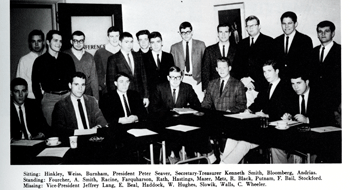A Workshop in Democracy: Student Government at Bowdoin College, 1945-1980






Offering courses in political science, for instance, the College’s academic curriculum has sought to educate students for political engagement as well as foster in them the necessary skills for competent citizenship. The extra-curriculum, however, has also frequently served as a site for leadership and citizen development. One activity, in particular, has supported this form of learning -- the student government. In what ways has Bowdoin student government served as a practicum in democratic citizenship? What challenges and opportunities has the organization presented to students over time? What institutional structures, roles and processes have historically been in place to allow students to experience college governance first hand? Finally, how did student leaders negotiate their relationships with College faculty and administrators?
Between the end of World War II and the beginning of the 1980s, Bowdoin College served as an ideal workshop for student leaders. Through the general willingness of administrators and faculty to allow students to be part of College governance, and through negotiating and elaborating upon the relationships involved in that governance, student government incorporated its members into a comprehensive institutional structure, giving them specific rights and responsibilities. Through the successful (and occasionally unsuccessful) exercise of these rights, student government members developed policies and tested them through a formal legislative process. Student government at Bowdoin was the “mouthpiece” of the student body, interacting and engaging with College officials, sometimes as partners and at other times as adversaries. Through reform processes and electoral politics, students shaped their government in the ways that most suited their needs while learning about the benefits and costs of particular organizational structures. The mistakes made by students while governing were as important as the successes and, as a result, student government changed along with Bowdoin College.
In October 1969, the Bowdoin Student Council endorsed a statement of opposition to America’s involvement in Vietnam. Addressing a letter to President Nixon, Student Council President John B. Cole wrote, “We urgently request that our national policies be revised to end the war in Viet Nam immediately.” At Cole’s request, College President Roger Howell agreed to include a cover letter with his signature.
In October 1969, the Bowdoin Student Council endorsed a statement of opposition to America’s involvement in Vietnam. Addressing a letter to President Nixon, Student Council President John B. Cole wrote, “We urgently request that our national policies be revised to end the war in Viet Nam immediately.” At Cole’s request, College President Roger Howell agreed to include a cover letter with his signature.
In the late 1960s, a joint faculty student committee released “Student Representation on Faculty Committees at Bowdoin College,” a report that recommended significant student representation on College committees. By the end of that academic year, almost 200 students had expressed their interest in participating in college governance.
In 1969, Acting Dean Edward Geary (pictured here in 1966) observed, “Students now play a more active role in the governance of the College by serving on most of the standing committees. I believe that such service will also teach them a great deal about group psychology, the functioning of an educational institution and practical politics.”
Members of the 1963-1964 Student Council urged Bowdoin officials to “liberalize” campus social rules and reform the institution’s social code, especially the College’s chapel attendance policy.
Proclaiming the “right and ability to govern” themselves, Bowdoin College students revised their Student Council’s constitution in 1969, a year marked by controversy and upheaval in student-college relations.
Story by Dustin Brooks, '08
Sources: John C. Cole, Bowdoin Student Council. “Letter to Pres. Howell, 22 May 1969,” Roger Howell Administrative Records 1952-1993: 1969 [1.2.10.1], Bowdoin College Special Collections; “Edward Geary” 1966 Bowdoin College Bugle, 22; “Student Council” 1964 Bowdoin College Bugle, 37; “Constitution of the Bowdoin Student Council,” Roger Howell Administrative Records 1952-1993: 1969 [1.2.10.1], Bowdoin College Special Collections; John C. Cole, Bowdoin Student Council. “Letter to the President of the United States, 9 October 1969,” Roger Howell Administrative Records 1952-1993: 1969 [1.2.10.1], Bowdoin College Special Collections; Pres. Roger Howell, Bowdoin College. “Letter to the President of the United States, 14 October 1969,” Roger Howell Administrative Records 1952-1993: 1969 [1.2.10.1], Bowdoin College Special Collections.